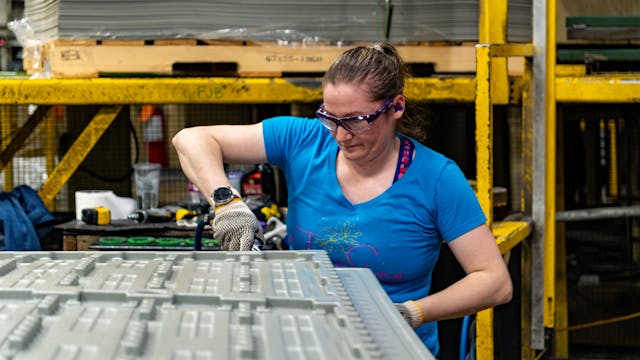Laura VanBlaricum did the math. She couldn’t return to work — not with the cost of infant care in her Michigan community, on the low wages she was earning.
Left with no choice, she dropped out of the workforce, like millions of American women have had to do. It was 2020.
A year later, she tried again. She bounced around a couple of different jobs, looking for a company that would provide her with a livable wage and a reason to stay, until finally, in early 2022, she found one.
VanBlaricum works as a machine operator and assembler at a manufacturing plant that molds plastic parts for automotive companies in Standish, Michigan. The job is physically demanding. Shifts can run 12 hours in the hot, grueling conditions necessary to heat and shape the plastic. Many employees of Vantage Plastics, as a result, don’t last long.
Yet VanBlaricum remains — in part, she says, because one of the benefits of this job is too good to give up.
Vantage Plastics is one of more than 169 employers participating in Michigan’s Tri-Share program, a cost-sharing approach where the state, the employer and the employee each pay for one-third of the price of child care, effectively giving families a 66 percent discount. For an expense that runs higher, in most places, than in-state college tuition, and exceeds some families’ mortgage payments, that workplace benefit can amount to a substantial raise.

The program has provided tremendous financial relief to VanBlaricum, who is saving thousands of dollars annually. Tri-Share allows her family of five to afford many goods and services they previously did without, including cable and internet.
“It’s more food on the table, more clothes,” she says.
Launched in early 2021, the bipartisan program began as a three-region pilot to address what had become a glaring issue: the prohibitive cost of child care. After at least 136,000 women in Michigan left the workforce during the pandemic, many people started to realize how integral child care is to the economy. A study published earlier this year estimated that the United States loses about $122 billion annually due to inadequate child care. A separate report, published this fall, found that Michigan could recoup nearly $3 billion a year by providing accessible, affordable child care to working families.
Tri-Share debuted as a possible solution, a public-private partnership to help modest-income families shoulder the high cost of child care and, in turn, allow Michiganders like VanBlaricum — most of whom are women — to re-enter and remain in the workforce. In the brief time since its launch, Tri-Share has expanded to 59 of the 83 counties in Michigan and attracted the attention of leaders across the country, several of which have adaptations of the model already underway in their own states.
Proponents of Tri-Share recognize that this program alone will not remedy the many afflictions of the early care and education sector. But they believe it could go a long way toward supporting working families and strengthening the U.S. labor force.
“We have to change something in child care,” says Kristina Bajtka, who oversees Tri-Share adoption in northwest Michigan, “and this is one piece of that puzzle.”
Laying the Groundwork
It was early 2019, and Greg VanWoerkom, a Republican, had just been sworn in for his first term in the Michigan House of Representatives. Among the issues he was eager to address was child care. With three young children of his own, he knew firsthand how difficult it could be to find and afford, and he saw how universally vexing it was for families, nonprofit leaders and business executives in his district.
Once in office, he began researching the issue and joined a local working group focused on child care. He wanted to understand the experiences of child care providers and the public programs already available to support families.
And then one day that spring, he sketched out an idea. Using a spoke and wheel model, his drawing included a “facilitator hub” at the center, acting as an intermediary between families, child care providers and employers. (VanWoerkom concedes that he might have drawn the plan up on a napkin, where “all great ideas start.”)
The sketch became the early outline of Tri-Share.

Here’s how it works. An employer signs on to the program through a local facilitator hub (often a community-based nonprofit). The hub handles all administrative tasks, including vetting employee applications and determining eligibility, paying child care providers directly, and billing employers and the state for their portions. The hub also supports families in finding licensed child care that meets their needs.
The hub ensures that providers are paid consistently and on time, employers aren’t saddled with additional administrative tasks, and employees’ financial circumstances remain private.
The concept garnered broad bipartisan support, including from Gov. Gretchen Whitmer, a Democrat. Two years later, in March 2021, the pilot launched with an initial $1.1 million grant.
Employers immediately saw improvements in retention, says Cheryl Bergman, CEO of the Michigan Women’s Commission, which the governor tapped to lead the pilot and administer the program.
“It’s a workforce development program,” says Bergman, “and it is changing people’s lives.”
To be eligible for Tri-Share, employees must have a household income between 200 and 325 percent of the federal poverty level — between $60,000 and $97,500 for a family of four. Below that threshold, families are eligible for the state’s child care subsidy program, which covers up to 100 percent of the cost. Above it, in theory, families are in a financial position to afford the full price of child care.
“This program picks up where the child care subsidy leaves off,” Bergman says. “It’s meant to help those people who make too much to qualify for the child care subsidy in the state but still struggle to afford child care.”
Amy Breitner falls into that category. She is a graphic designer for Crystal Mountain, a ski resort about 15 miles from the coast of Lake Michigan. She and her husband both work full-time. Their combined income is over the limit for the state subsidy, but they still feel crushed by the cost of child care.
“We don’t live a lavish lifestyle. We’re frugal and do our best to manage our money well,” Breitner shares. “But we were always behind on our day care bills. Always.”
That changed when she learned that Crystal Mountain was participating in Tri-Share, and that she qualified. She could even keep using her current child care provider. (She says that, as much as her family needed the financial relief, she likely wouldn’t have signed up if it meant she had to leave the trusted provider who has cared for all three of her children.)

Since joining Tri-Share almost two years ago, Breitner and her husband haven’t missed a payment, and because it can be used for summer and after-school care too, Breitner was able to send her 9-year-old to summer camp this year.
The money back in their pockets has helped them get on top of expenses such as medical bills and student loans. “It is so nice,” Breitner says, “to be current on my payments.”
Slow to Grow
The last time Breitner checked, she was the only employee at her company enrolled in Tri-Share. “Why that is,” she says, “is absolutely beyond me. It is an insanely helpful program.”
It’s not just Crystal Mountain. Vantage Plastics, with 400 employees, has only three taking advantage of the benefit.
When Shape Corp., an auto supplier with more than 1,500 employees in southwest Michigan, signed on, the company added its own criteria, limiting the program to full-time employees who had worked there for over a year, and covering only one child per family. The company had reserved 10 child care slots.
“We were fully prepared to do a lottery, to raffle off the slots,” says Erica Phelps, a health and well-being specialist for Shape Corp. “We thought we’d be overwhelmed with people.”
They weren’t.

Within a couple of months, the company eased up on some of its eligibility requirements. Still, today, just seven families from Shape Corp. are enrolled. (Each child, Phelps says, costs the company an average of $300 a month.)
Tri-Share offers families a significant cost savings on what is typically one of their biggest monthly expenses. Participants laud its ease of use and love that they can keep their provider, as long as that provider is licensed. So why aren’t more of them using it?
Some say it’s a communication issue. Many employers don’t yet know the program exists, and some employers that offer it may have employees who don’t know about it.
“We are finding that just getting the word out, that it’s available, is a big challenge,” says Bergman.
There have been other hangups. Some companies have been reluctant to roll out a benefit that relies on continued state funding. In the event of an economic downturn, many employers worry the program would be among the first to go. They don’t want to promote a program and then abruptly pull out of it in a recession, when families need it most.
Perhaps the biggest barrier, though, is that many families who want to enroll are earning slightly over the eligibility cap.
"What we’ve been finding across multiple industries — school districts, semiconductors, manufacturing — is that the 325 percent cap should be the bottom of the threshold. A lot of families are just above it,” shares Rich Van Tol, who helps with employer outreach for one of the Tri-Share hubs.
If a family in Michigan has two young children — an infant and a 4-year-old, say — their child care costs at a center would average nearly $25,000 a year. That is not sustainable for a family earning 350 percent of the federal poverty level, or even 400 percent, says Van Tol.
“That’s so high,” he says, “that one parent is going to end up staying at home. It ends up disproportionately hurting women.”
If Tri-Share is going to be the state’s solution to the workforce problem, Van Tol says, then it needs to have a higher income limit.
“It’s a beautiful idea that has so much potential,” he says, “but we’re just not capitalizing on it yet because of that eligibility band.”
A Steady Path To Sustainability
As of October, 489 children from 376 families across Michigan were enrolled in Tri-Share.
Those modest numbers belie the steady growth the program has seen since its inception, Bergman says, noting that family participation has increased about 10 percent every month for the last year.
Besides, a slow start may not be such a bad thing, if it’s allowed for a better paced and more prudent rollout.
VanWoerkom, the state representative, wants to prove that Tri-Share works and ensure its sustainability before bringing it to scale.
“I still think this is in its infancy yet, of proving the model works,” he says.
Marcus Keech, who was involved with Tri-Share from “day zero” as VanWoerkom’s legislative director, doesn’t believe the program has reached its perfect form. He suggests that one of the states currently trying to replicate the model — North Carolina, New York, Kentucky, a county in Indiana — could in fact get there first.
“If they can take our program and make it better, I’m not offended by it,” says Keech, who now works for the Grand Rapids Chamber of Commerce.
In the meantime, the program in Michigan is constantly evolving.
“I think we’re getting more organic growth, it’s building more steam, building interest every month,” says Bajtka, director of Tri-Share at the hub in northwest Michigan. “It’s on a positive trajectory and can only go up from here.”

Several changes are currently underway to simplify and streamline the forces that power Tri-Share, shifts that should usher in improvements and growth, Bergman explains. By next summer, if all goes according to plan, she thinks Tri-Share will be available statewide.
“I think it’s going to explode,” Bergman says, adding that she’s in conversation with leaders from big companies like General Motors and Henry Ford Health.
Tri-Share is projected to reach 7,500 children across 5,000 households statewide by 2028, according to a five-year plan released by the Michigan Women’s Commission. To accommodate those families, the state would need to spend about $40 million a year on Tri-Share, more than 10 times the amount it’s allocating now.
That’s a realistic trajectory, Bergman says. The program has even had a couple of private foundations chip in with support because they believe in the program and want to be a part of its success.
“Employers need workers, and families need affordable, accessible child care,” says Bergman. “This program solves for both. It’s doing both. And it’s working.”


